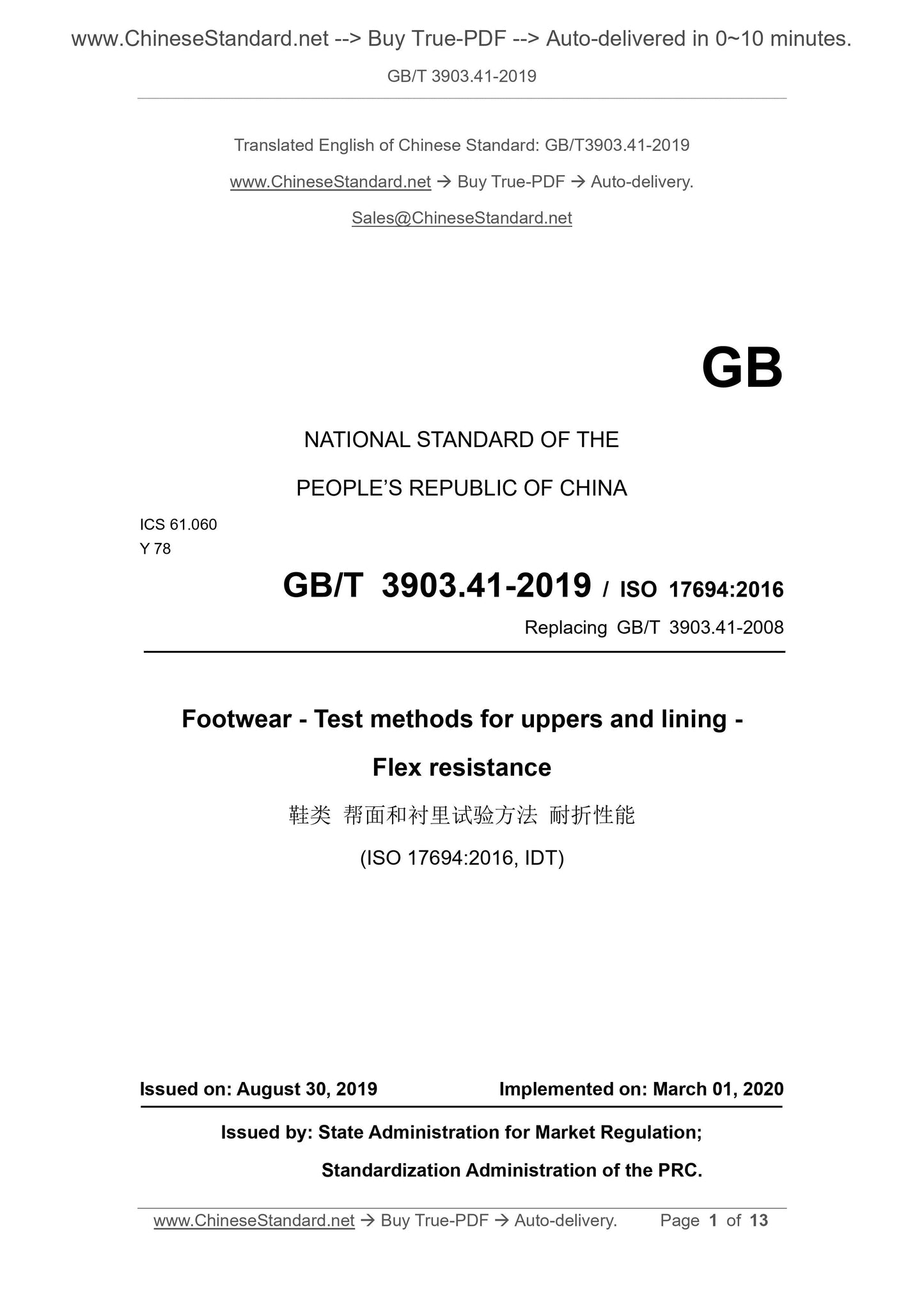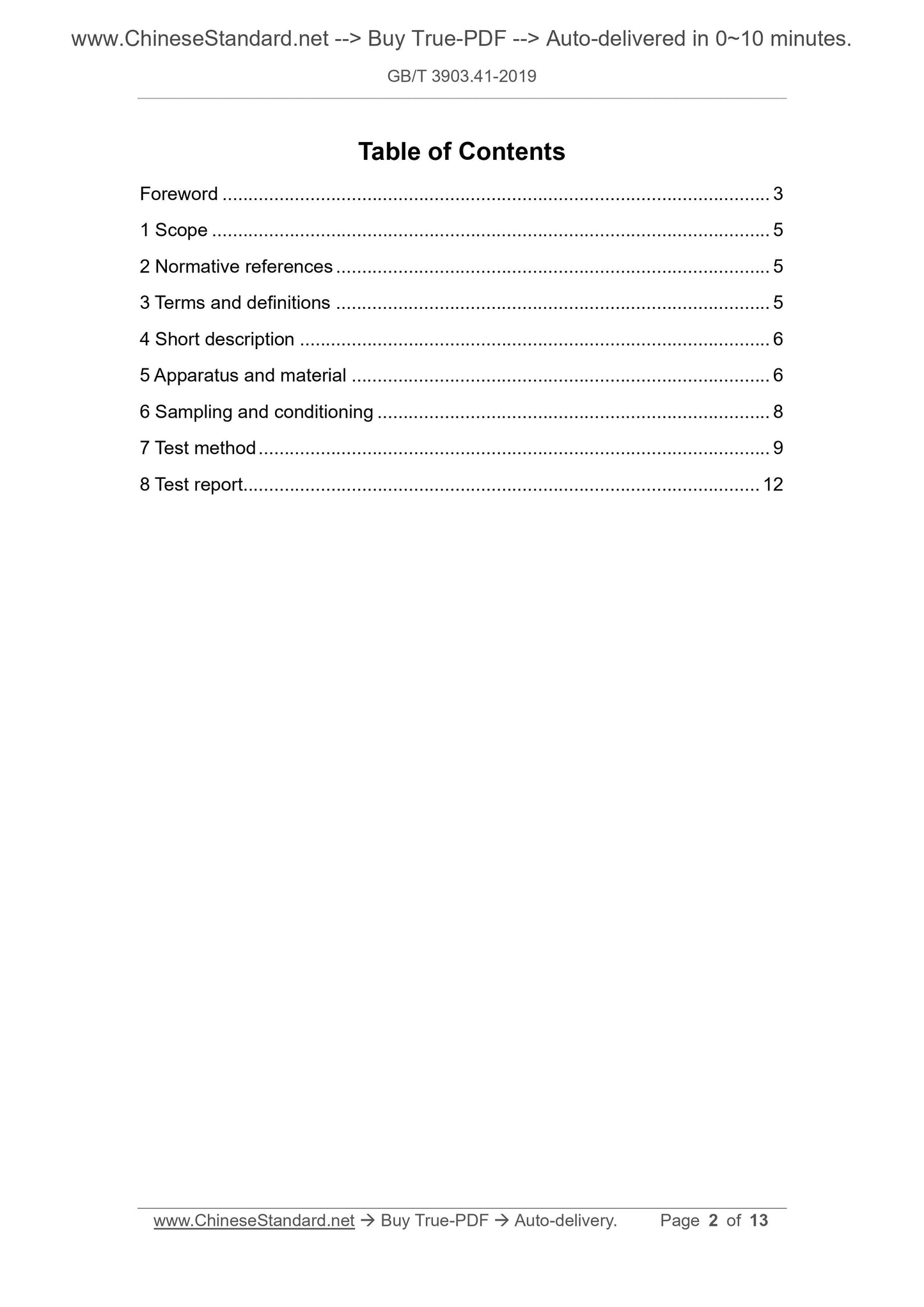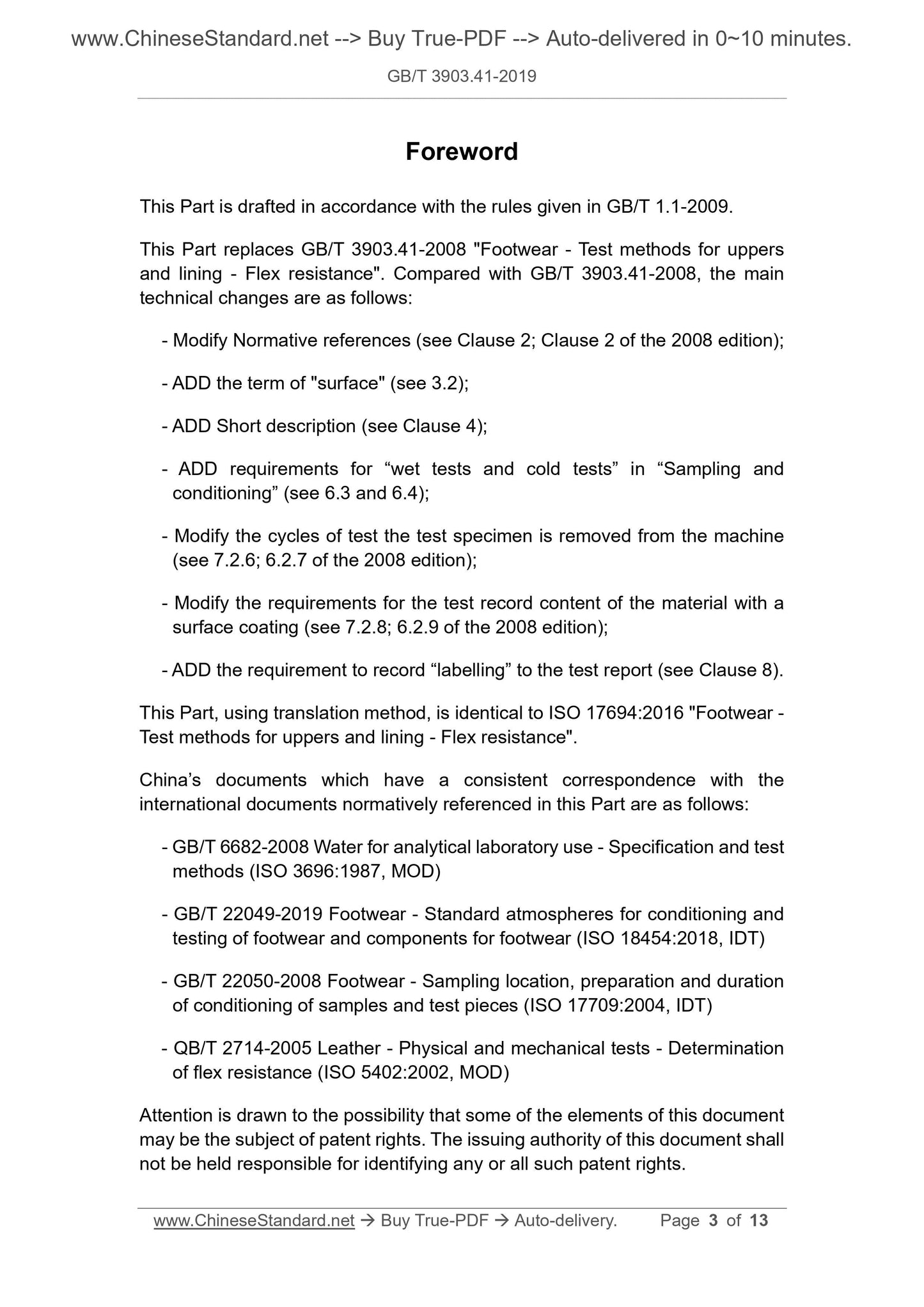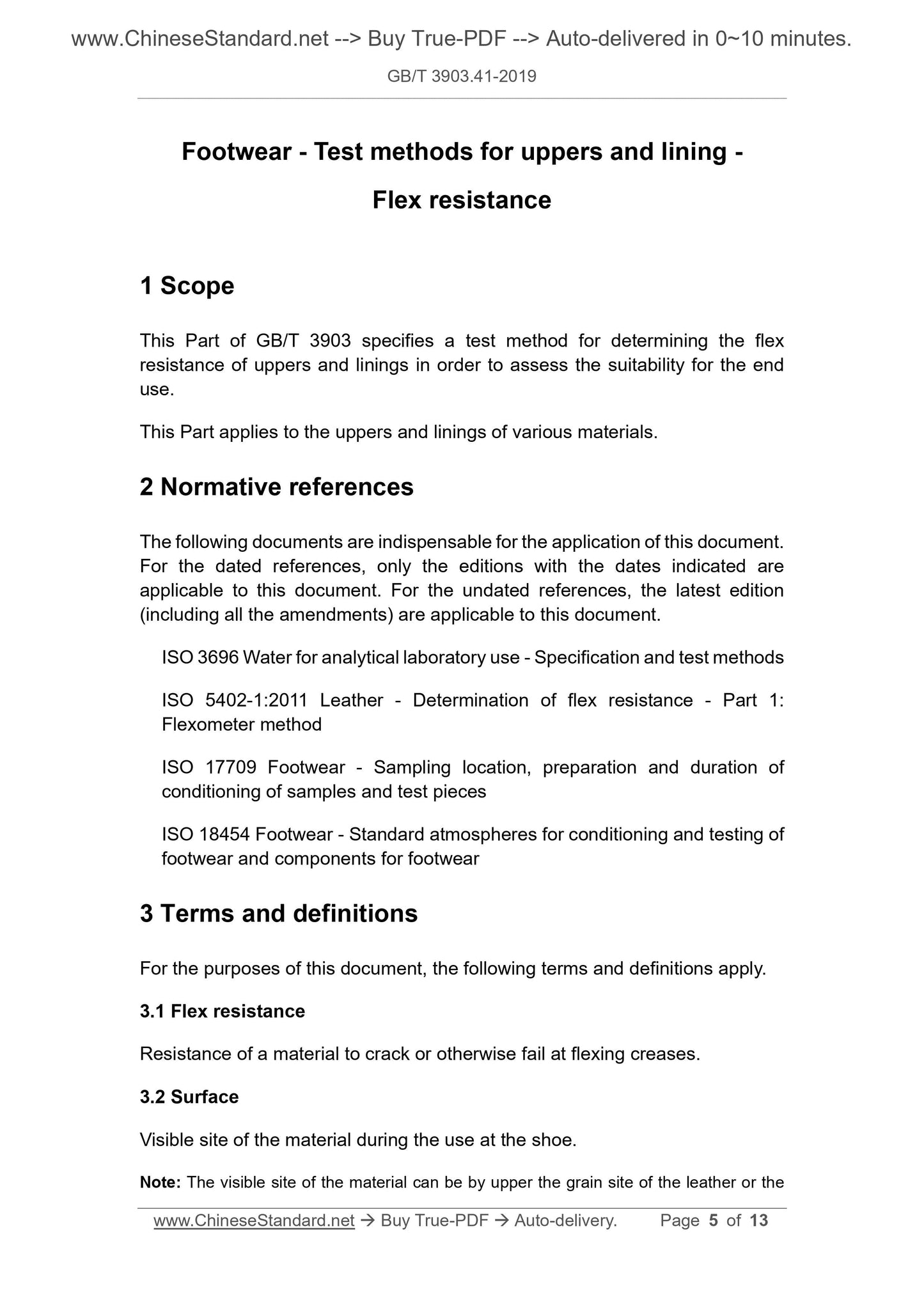1
/
su
4
PayPal, credit cards. Download editable-PDF and invoice in 1 second!
GB/T 3903.41-2019 English PDF (GBT3903.41-2019)
GB/T 3903.41-2019 English PDF (GBT3903.41-2019)
Prezzo di listino
$125.00 USD
Prezzo di listino
Prezzo scontato
$125.00 USD
Prezzo unitario
/
per
Spese di spedizione calcolate al check-out.
Impossibile caricare la disponibilità di ritiro
Delivery: 3 seconds. Download true-PDF + Invoice.
Get QUOTATION in 1-minute: Click GB/T 3903.41-2019
Historical versions: GB/T 3903.41-2019
Preview True-PDF (Reload/Scroll if blank)
GB/T 3903.41-2019: Footwear -- Test methods for uppers and lining -- Flex resistance
GB/T 3903.41-2019
Footwear - Test methods for uppers and lining - Flex resistance
ICS 61.060
Y78
National Standards of People's Republic of China
Replace GB/T 3903.41-2008
Footwear and lining test methods
(ISO 17694.2016, IDT)
Published on.2019-08-30
2020-03-01 implementation
State market supervision and administration
China National Standardization Administration issued
Foreword
This part is drafted in accordance with the rules given in GB/T 1.1-2009.
This part replaces GB/T 3903.41-2008 "Foot-resistant upper and lining test methods for folding performance", and GB/T 3903.41-
Compared to.2008, the main technical changes are as follows.
--- Revised the normative reference document (see Chapter 2, Chapter 2 of the.2008 edition);
--- Added the term "surface" (see 3.2);
--- Added an overview (see Chapter 4);
--- Added requirements for "wet test, low temperature test" in "Sampling and Environmental Regulation" (see 6.3 and 6.4);
--- Revised the number of tests the sample was removed from the machine (see 7.2.6, 6.2.7 for the.2008 version);
--- Revised the requirements for the recorded content of the coated material on the surface (see 7.2.8, 6.2.9 of the.2008 edition);
--- The test report has added requirements for the record "label" (see Chapter 8).
This section uses the translation method equivalent to ISO 17694.2016 "Footwear lining and lining test method folding performance".
The documents of our country that have a consistent correspondence with the international documents referenced in this part are as follows.
---GB/T 6682-2008 Analytical laboratory water specifications and test methods (ISO 3696.1987, MOD)
---GB/T 22049-2019 Standard environment for environmental conditioning and testing of footwear footwear and footwear components (ISO 18454.2018,
IDT)
---GB/T 22050-2008 Sampling position, preparation and environmental adjustment time of footwear samples and samples (ISO 17709.2004,
IDT)
---QB/T 2714-2005 Determination of the fastness to the physical and mechanical tests of leather (ISO 5402.2002, MOD)
Please note that some of the contents of this document may involve patents. The issuing organization of this document is not responsible for identifying these patents.
This part was proposed by the China Light Industry Federation.
This part is under the jurisdiction of the National Technical Committee for the Standardization of Footwear (SAC/TC305).
This section drafted by. Quanzhou Ryukyu Shoes Co., Ltd., China Leather Shoes Research Institute Co., Ltd.
The main drafters of this section. Yang Yumei, Qin Xiaobo, Chen Jingyi.
The previous versions of the standards replaced by this section are.
---GB/T 3903.41-2008.
Footwear and lining test methods
1 Scope
This part of GB/T 3903 specifies the test method for determining the folding resistance of the upper and the lining. The purpose is to evaluate the suitability of the end use.
Suitability.
This section applies to the upper faces and linings of various materials.
2 Normative references
The following documents are indispensable for the application of this document. For dated references, only dated versions apply to this article.
Pieces. For undated references, the latest edition (including all amendments) applies to this document.
ISO 3696 Analytical Laboratory Water Specifications and Test Methods (Waterforanalyticallaboratoryuse-Specification)
Andtestmethods)
ISO 5402-1.2011 Determination of the fastness of leather - Part 1 . Deflection method (Leather-Determinationofflex
resistance-Part 1. Flexometermethod)
ISO 17709 Sampling position, preparation and environmental conditioning time for footwear samples and specimens (Footwear-Samplinglocation,
Preparationanddurationofconditioningofsamplesandtestpieces)
ISO 18454 Standard environment for environmental conditioning and testing of footwear footwear and footwear components (Footwear-Standardatmospheres
Forconditioningandtestingoffootwearandcomponentsforfootwear)
3 Terms and definitions
The following terms and definitions apply to this document.
3.1
Flexibility resistance
The ability of the material to resist cracking or resist other damage at the crease.
3.2
Surface surface
The visible portion of the shoe material when wearing the shoe.
Note. The visible part of the material, for the upper surface, for example, the grained portion of the leather or the coated portion of the coated fabric, for the lining, the visible material inside the shoe
section.
4 Overview
The sample was cut from the upper or the shoe material, folded and clamped into the testing machine. Test simulates the damage caused by the inward bending of the upper, but not
It can better simulate the damage of outward bending. The test is carried out under wet, dry or low temperature conditions.
5 Test equipment and materials
The following test equipment and materials should be used.
5.1 Test machine, in accordance with ISO 5402-1.2011 (4.1) includes.
5.1.1 At least four pairs of clamps. The upper clamp consists of a pair of plates, see Figure 1. Lower clamp clamp fixed, perpendicular to the upper clamp
On the surface.
The unit is mm
Description.
1---bending angle 22°30'±0°30';
2---fixing clamp fastening screw;
3---fillet radius 2mm;
4---horizontal axis.
Figure 1 Upper clamp size
5.1.2 Upper clamp clamp, can swing back and forth, the swing angle is 22°30'±0°30'. The swing rate is (100 ± 5) r/min. Upper clamp
When the clamp is in the horizontal position, the distance between the upper and lower clamps is (25 ± 1) mm.
5.1.3 Counter, record the total number of swings.
5.2 Die cutter, size (70 ± 1) mm × (45 ± 1) mm, or use a similar tool for sampling.
5.3 Optical magnifying glass, the magnification is about 4 to 6 times.
5.4 For wet samples, the following instruments and materials are required.
5.4.1 Glassware, at least 100mm in diameter and 25mm in depth.
5.4.2 Distilled or deionized water shall comply with the requirements of Class 3 water in ISO 3696.
5.4.3 Filter paper.
5.4.4 Dryer, or other container that can be evacuated.
5.4.5 Vacuum pump, the dryer can be vacuumed to below 4kPa.
5.5 For the low temperature folding test, the freezer can keep the internal air temperature at (-5±2) °C, and the space inside the freezer is large enough to be placed.
Test equipment. If necessary, the temperature can be reduced to -30 °C.
6 Sampling and environmental conditioning
6.1 General
Use a die cutter to cut a specified number of rectangular specimens (see Table 1). The sample is equally divided into two groups, and the long side of one set of samples is parallel to the length of the material.
Direction of the direction (the leather is in the direction of the back ridge, the non-leather material is the warp direction or the machine extrusion direction), and the other set of specimens is perpendicular to the length of the material.
to. For sampling from the upper surface, the material length direction is the X-axis direction defined in ISO 17709.
For the upper surface, take a sample from the center of the front sill to ensure that the center of the specimen is the position where the shoe is most bent.
For sheets, samples are taken over the entire width and length available. For materials containing woven structures, avoid any two samples that are identical
Warp or weft.
For some types of shoes, especially children's shoes, it may not be possible to take large enough samples from the shoes. At this point, the width of the sample can be slightly reduced, but
The length (70 ± 1) mm should not be reduced. How...
Get QUOTATION in 1-minute: Click GB/T 3903.41-2019
Historical versions: GB/T 3903.41-2019
Preview True-PDF (Reload/Scroll if blank)
GB/T 3903.41-2019: Footwear -- Test methods for uppers and lining -- Flex resistance
GB/T 3903.41-2019
Footwear - Test methods for uppers and lining - Flex resistance
ICS 61.060
Y78
National Standards of People's Republic of China
Replace GB/T 3903.41-2008
Footwear and lining test methods
(ISO 17694.2016, IDT)
Published on.2019-08-30
2020-03-01 implementation
State market supervision and administration
China National Standardization Administration issued
Foreword
This part is drafted in accordance with the rules given in GB/T 1.1-2009.
This part replaces GB/T 3903.41-2008 "Foot-resistant upper and lining test methods for folding performance", and GB/T 3903.41-
Compared to.2008, the main technical changes are as follows.
--- Revised the normative reference document (see Chapter 2, Chapter 2 of the.2008 edition);
--- Added the term "surface" (see 3.2);
--- Added an overview (see Chapter 4);
--- Added requirements for "wet test, low temperature test" in "Sampling and Environmental Regulation" (see 6.3 and 6.4);
--- Revised the number of tests the sample was removed from the machine (see 7.2.6, 6.2.7 for the.2008 version);
--- Revised the requirements for the recorded content of the coated material on the surface (see 7.2.8, 6.2.9 of the.2008 edition);
--- The test report has added requirements for the record "label" (see Chapter 8).
This section uses the translation method equivalent to ISO 17694.2016 "Footwear lining and lining test method folding performance".
The documents of our country that have a consistent correspondence with the international documents referenced in this part are as follows.
---GB/T 6682-2008 Analytical laboratory water specifications and test methods (ISO 3696.1987, MOD)
---GB/T 22049-2019 Standard environment for environmental conditioning and testing of footwear footwear and footwear components (ISO 18454.2018,
IDT)
---GB/T 22050-2008 Sampling position, preparation and environmental adjustment time of footwear samples and samples (ISO 17709.2004,
IDT)
---QB/T 2714-2005 Determination of the fastness to the physical and mechanical tests of leather (ISO 5402.2002, MOD)
Please note that some of the contents of this document may involve patents. The issuing organization of this document is not responsible for identifying these patents.
This part was proposed by the China Light Industry Federation.
This part is under the jurisdiction of the National Technical Committee for the Standardization of Footwear (SAC/TC305).
This section drafted by. Quanzhou Ryukyu Shoes Co., Ltd., China Leather Shoes Research Institute Co., Ltd.
The main drafters of this section. Yang Yumei, Qin Xiaobo, Chen Jingyi.
The previous versions of the standards replaced by this section are.
---GB/T 3903.41-2008.
Footwear and lining test methods
1 Scope
This part of GB/T 3903 specifies the test method for determining the folding resistance of the upper and the lining. The purpose is to evaluate the suitability of the end use.
Suitability.
This section applies to the upper faces and linings of various materials.
2 Normative references
The following documents are indispensable for the application of this document. For dated references, only dated versions apply to this article.
Pieces. For undated references, the latest edition (including all amendments) applies to this document.
ISO 3696 Analytical Laboratory Water Specifications and Test Methods (Waterforanalyticallaboratoryuse-Specification)
Andtestmethods)
ISO 5402-1.2011 Determination of the fastness of leather - Part 1 . Deflection method (Leather-Determinationofflex
resistance-Part 1. Flexometermethod)
ISO 17709 Sampling position, preparation and environmental conditioning time for footwear samples and specimens (Footwear-Samplinglocation,
Preparationanddurationofconditioningofsamplesandtestpieces)
ISO 18454 Standard environment for environmental conditioning and testing of footwear footwear and footwear components (Footwear-Standardatmospheres
Forconditioningandtestingoffootwearandcomponentsforfootwear)
3 Terms and definitions
The following terms and definitions apply to this document.
3.1
Flexibility resistance
The ability of the material to resist cracking or resist other damage at the crease.
3.2
Surface surface
The visible portion of the shoe material when wearing the shoe.
Note. The visible part of the material, for the upper surface, for example, the grained portion of the leather or the coated portion of the coated fabric, for the lining, the visible material inside the shoe
section.
4 Overview
The sample was cut from the upper or the shoe material, folded and clamped into the testing machine. Test simulates the damage caused by the inward bending of the upper, but not
It can better simulate the damage of outward bending. The test is carried out under wet, dry or low temperature conditions.
5 Test equipment and materials
The following test equipment and materials should be used.
5.1 Test machine, in accordance with ISO 5402-1.2011 (4.1) includes.
5.1.1 At least four pairs of clamps. The upper clamp consists of a pair of plates, see Figure 1. Lower clamp clamp fixed, perpendicular to the upper clamp
On the surface.
The unit is mm
Description.
1---bending angle 22°30'±0°30';
2---fixing clamp fastening screw;
3---fillet radius 2mm;
4---horizontal axis.
Figure 1 Upper clamp size
5.1.2 Upper clamp clamp, can swing back and forth, the swing angle is 22°30'±0°30'. The swing rate is (100 ± 5) r/min. Upper clamp
When the clamp is in the horizontal position, the distance between the upper and lower clamps is (25 ± 1) mm.
5.1.3 Counter, record the total number of swings.
5.2 Die cutter, size (70 ± 1) mm × (45 ± 1) mm, or use a similar tool for sampling.
5.3 Optical magnifying glass, the magnification is about 4 to 6 times.
5.4 For wet samples, the following instruments and materials are required.
5.4.1 Glassware, at least 100mm in diameter and 25mm in depth.
5.4.2 Distilled or deionized water shall comply with the requirements of Class 3 water in ISO 3696.
5.4.3 Filter paper.
5.4.4 Dryer, or other container that can be evacuated.
5.4.5 Vacuum pump, the dryer can be vacuumed to below 4kPa.
5.5 For the low temperature folding test, the freezer can keep the internal air temperature at (-5±2) °C, and the space inside the freezer is large enough to be placed.
Test equipment. If necessary, the temperature can be reduced to -30 °C.
6 Sampling and environmental conditioning
6.1 General
Use a die cutter to cut a specified number of rectangular specimens (see Table 1). The sample is equally divided into two groups, and the long side of one set of samples is parallel to the length of the material.
Direction of the direction (the leather is in the direction of the back ridge, the non-leather material is the warp direction or the machine extrusion direction), and the other set of specimens is perpendicular to the length of the material.
to. For sampling from the upper surface, the material length direction is the X-axis direction defined in ISO 17709.
For the upper surface, take a sample from the center of the front sill to ensure that the center of the specimen is the position where the shoe is most bent.
For sheets, samples are taken over the entire width and length available. For materials containing woven structures, avoid any two samples that are identical
Warp or weft.
For some types of shoes, especially children's shoes, it may not be possible to take large enough samples from the shoes. At this point, the width of the sample can be slightly reduced, but
The length (70 ± 1) mm should not be reduced. How...
Share








